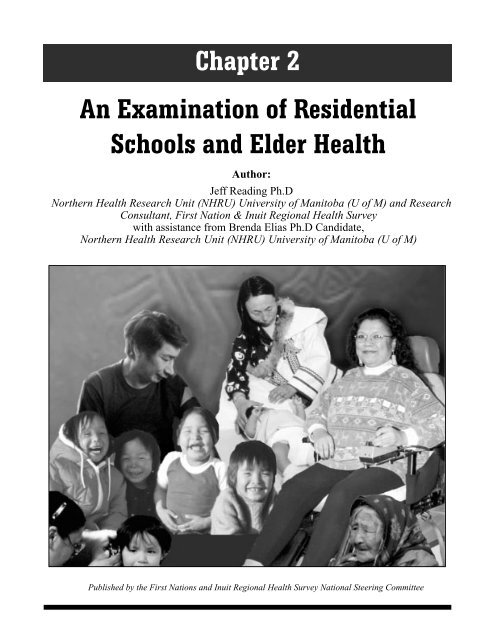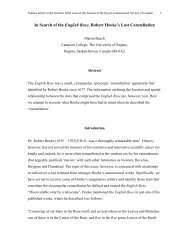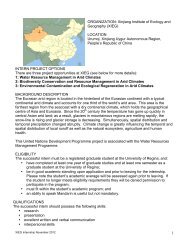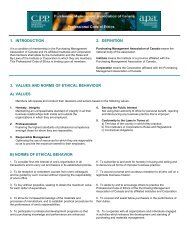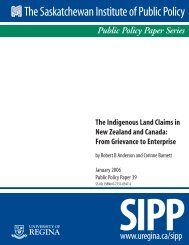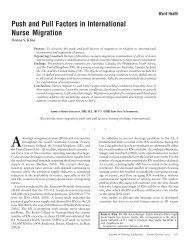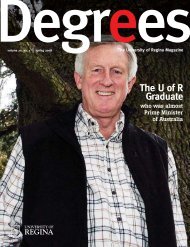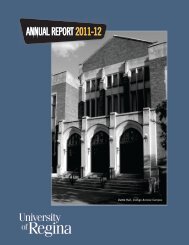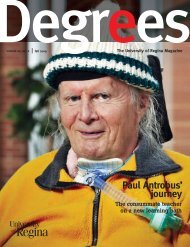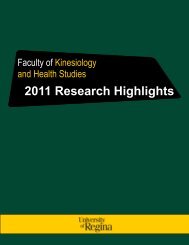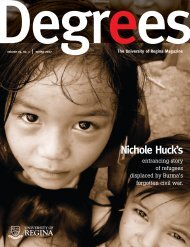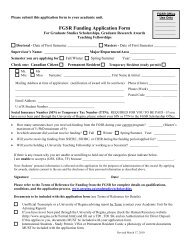An Examination of Residential Schools and Elder Health Chapter 2
An Examination of Residential Schools and Elder Health Chapter 2
An Examination of Residential Schools and Elder Health Chapter 2
You also want an ePaper? Increase the reach of your titles
YUMPU automatically turns print PDFs into web optimized ePapers that Google loves.
<strong>Chapter</strong> 2<br />
<strong>An</strong> <strong>Examination</strong> <strong>of</strong> <strong>Residential</strong><br />
<strong>Schools</strong> <strong>and</strong> <strong>Elder</strong> <strong>Health</strong><br />
Author:<br />
Jeff Reading Ph.D<br />
Northern <strong>Health</strong> Research Unit (NHRU) University <strong>of</strong> Manitoba (U <strong>of</strong> M) <strong>and</strong> Research<br />
Consultant, First Nation & Inuit Regional <strong>Health</strong> Survey<br />
with assistance from Brenda Elias Ph.D C<strong>and</strong>idate,<br />
Northern <strong>Health</strong> Research Unit (NHRU) University <strong>of</strong> Manitoba (U <strong>of</strong> M)<br />
Published by the First Nations <strong>and</strong> Inuit Regional <strong>Health</strong> Survey National Steering Committee
<strong>Residential</strong> <strong>Schools</strong> <strong>and</strong> <strong>Elder</strong> <strong>Health</strong><br />
TABLE OF CONTENTS<br />
List <strong>of</strong> Figures 29<br />
List <strong>of</strong> Tables 29<br />
Introduction <strong>and</strong> Background 30<br />
Methods 31<br />
Review <strong>of</strong> Literature 32<br />
Indian <strong>and</strong> Inuit <strong>Residential</strong> <strong>Schools</strong> in Canada 32<br />
Harms Caused by <strong>Residential</strong> Schooling 34<br />
Physical <strong>and</strong> consequent Emotional Harm to Children 34<br />
Educational Harm 34<br />
Loss <strong>of</strong> Culture <strong>and</strong> Language 34<br />
Harm to Family Structures 34<br />
<strong>Health</strong> Conditions <strong>of</strong> <strong>Elder</strong>s 36<br />
Socio-cultural Factors 36<br />
Family Support Net works 37<br />
<strong>Health</strong> <strong>and</strong> Social Services 37<br />
Mental <strong>Health</strong> 38<br />
<strong>Elder</strong> Abuse 38<br />
Poverty 38<br />
Results 40<br />
Discussion 48<br />
References 52<br />
First Nations <strong>and</strong> Inuit Regional <strong>Health</strong> Survey
<strong>Residential</strong> <strong>Schools</strong> <strong>and</strong> <strong>Elder</strong> <strong>Health</strong> 29<br />
LIST OF FIGURES<br />
Figure 1. Age by Gender 40<br />
Figure 2 Aboriginal Language Used Daily by Age 40<br />
Figure 3. Highest level <strong>of</strong> Education 41<br />
Figure 4. Excellant / Good Self reported <strong>Health</strong> Status By Gender <strong>and</strong> Age 41<br />
Figure 5. Poor / Fair Self-reported <strong>Health</strong> Status by Smoking Behavior <strong>and</strong> Age 42<br />
Figure 6. Asthma by Pack-Years Smoking <strong>and</strong> Age Group 42<br />
Figure 7. Breathing Problems by Pack-Years Smoking <strong>and</strong> Age Group 42<br />
Figure 8. High Blood Pressure by Pack-Years Smoking <strong>and</strong> Age Group 43<br />
Figure 9. At Least One Chronic <strong>Health</strong> Problem by Gender <strong>and</strong> Age 43<br />
Figure 10. Diabetes Alone <strong>and</strong> Cardiovascular Co-Morbidity in the Presence <strong>of</strong> Diabetes 44<br />
Figure 11. Diabetes Alone <strong>and</strong> Cardiovascular Co-Morbidity in the Presence <strong>of</strong> Diabetes by Age 44<br />
Figure 12. Rank Order <strong>of</strong> <strong>Health</strong> Services in Need <strong>of</strong> Improvement 45<br />
Figure 13. Disability <strong>and</strong> Activity Limitation 45<br />
Figure 14. Community Progress Over the Last Two Years 46<br />
Figure 15. Community Progress <strong>and</strong> Wellness 46<br />
Figure 16. More Than One Year Since Last Received Dental Care by Gender <strong>and</strong> Age 47<br />
Figure 17. Dental Treatment Needed at the Time <strong>of</strong> Survey by Gender <strong>and</strong> Age 47<br />
Figure 18. <strong>Residential</strong> School Attendance by Gender <strong>and</strong> Age 47<br />
Figure 19. Determinants <strong>of</strong> <strong>Health</strong> - Shaded Factors Theoretically Impacted by <strong>Residential</strong> School 50<br />
LIST OF TABLES<br />
Table 1. Estimated life expectancy at birth, total population,<br />
Inuit <strong>and</strong> Registered Indian, 1991. 32<br />
Table 2. Life expectancy at birth, age 30 <strong>and</strong> age 60, Registered Indian<br />
<strong>and</strong> Total Populations, 1978-81, 1982-85 <strong>and</strong> 1990 33<br />
Table 3. First Nation <strong>and</strong> Inuit <strong>Elder</strong> Smoking Rates versus Canadian Population 41<br />
Table 4. Chronic Conditions, First Nations <strong>and</strong> Labrador Inuit compared<br />
to the Canadian Population: Age-gender-specific <strong>and</strong> age adjusted<br />
prevalence for self-reported heart problems, hypertension<br />
(high blood pressure), diabetes, arthritis <strong>and</strong> rheumatism 43<br />
First Nations <strong>and</strong> Inuit Regional <strong>Health</strong> Surveys
30 <strong>Residential</strong> <strong>Schools</strong> <strong>and</strong> <strong>Elder</strong> <strong>Health</strong><br />
INTRODUCTION AND<br />
BACKGROUND<br />
Ultimately, everyone has a vested interest in maintaining optimal<br />
health <strong>and</strong> wellness particularly with advancing age. Those<br />
fortunate enough to live to an old age will likely be personally confronted<br />
with some <strong>of</strong> the health <strong>and</strong> social issues that accompany aging.<br />
Population demographic trends show that the numbers <strong>of</strong> First Nations<br />
<strong>and</strong> Inuit elder peoples are increasing. Presently, <strong>and</strong> to a greater degree in<br />
the future, aboriginal society will increasingly encounter the aging <strong>of</strong><br />
family, friends <strong>and</strong> community members. Thus, the broad health issues<br />
associated with aging need to be addressed.<br />
For the purposes <strong>of</strong> this report people in older adult age groups (45<br />
years +) were defined as ‘elders’ <strong>and</strong> not ‘middle age adults’ or ‘seniors’,<br />
since elders is an acceptable term used by Aboriginal peoples. The term<br />
elders was used here to signify age only, not the spiritual definition that is<br />
usually used in Aboriginal communities to define an <strong>Elder</strong>.<br />
Whereas an exp<strong>and</strong>ing body <strong>of</strong> information exists concerning the<br />
impact <strong>of</strong> residential school experiences on Aboriginal peoples in Canada,<br />
relatively little information exists regarding the current health status <strong>of</strong><br />
elders. This report was written to investigate the health <strong>of</strong> First Nations<br />
<strong>and</strong> Labrador Inuit elders living in their home communities. In addition,<br />
the report will explore the numbers <strong>of</strong> elders who attended residential<br />
schools.<br />
The Assembly <strong>of</strong> First Nations recognized the importance <strong>of</strong><br />
reconciling history to make sense <strong>of</strong> current health stating that:<br />
“First Nations need to know their history. History provides a context for<br />
underst<strong>and</strong>ing individuals’ present circumstances, <strong>and</strong> is an essential part <strong>of</strong> the<br />
healing process.”<br />
First Nations <strong>and</strong> Inuit Regional <strong>Health</strong> Surveys<br />
Assembly <strong>of</strong> First Nations (1994)<br />
A comprehensive examination <strong>of</strong> elder’s health status should begin by<br />
linking historical health determinants to social, political, environmental,<br />
economic <strong>and</strong> cultural influences. Thus, a study that proposes to examine<br />
the health status <strong>and</strong> social circumstances <strong>of</strong> elders living in their home<br />
communities in Canada cannot ignore the pervasive impact that<br />
residential schools have had on many individuals <strong>and</strong> the ripple effects<br />
felt throughout their families <strong>and</strong> communities. The reader is particularly<br />
encouraged to consider health survey indicators in a holistic context <strong>of</strong><br />
past residential school experiences as a significant cohort-specific<br />
determinant <strong>of</strong> health.<br />
The rationale for such an approach to underst<strong>and</strong>ing health is found in<br />
the ‘determinant <strong>of</strong> health’ conceptual framework that builds on the link<br />
between health status <strong>and</strong> income inequality (including poverty, lack <strong>of</strong><br />
education <strong>and</strong> under-employment) but extends to include a shift away<br />
from ‘material constraints’ to ‘social constraints’ as the limiting condition<br />
on quality <strong>of</strong> life (Wilkinson, R., 1994). In other words, health may be<br />
viewed as a holistic balance <strong>and</strong> harmony involving body, mind, emotions<br />
<strong>and</strong> spirit. Theoretically, residential school experiences seem to have
<strong>Residential</strong> <strong>Schools</strong> <strong>and</strong> <strong>Elder</strong> <strong>Health</strong> 31<br />
METHODS<br />
created fundamental inequalities that, in part, could have been manifest in<br />
the pr<strong>of</strong>ound poor health <strong>of</strong> elders when compared to their non-aboriginal<br />
counterparts in Canadian society. The aim <strong>of</strong> this report is to describe the<br />
health <strong>of</strong> First Nations <strong>and</strong> Labrodor Inuit elders, explore the complex<br />
multiple causative factors in the etiology <strong>of</strong> ill health <strong>and</strong> to make<br />
recommendations that fundamentally improve health. Failure to<br />
acknowledge the potential impacts <strong>of</strong> the past events <strong>and</strong> current social,<br />
political, economic <strong>and</strong> cultural circumstances in the complex etiology <strong>of</strong><br />
poor health will likely lead to an incomplete underst<strong>and</strong>ing <strong>of</strong> the root<br />
causes <strong>of</strong> ill health.<br />
I n<br />
January <strong>of</strong> 1996, a national steering committee (NSC) was struck to<br />
develop the FNIRHS. The NSC included membership from First<br />
Nations political organizations drawn from nine participating regions<br />
including Labrador, New Brunswick, Nova Scotia, Quebec, Ontario,<br />
Manitoba, Saskatchewan, Alberta <strong>and</strong> British Columbia. Two ex-<strong>of</strong>ficio<br />
members attended, one each from the Assembly <strong>of</strong> First Nations <strong>and</strong><br />
Medical Services Branch <strong>of</strong> <strong>Health</strong> Canada.<br />
All decisions were reached by consensus. The NSC managed the<br />
entire survey process including the development <strong>of</strong> national core<br />
questions, a detailed code <strong>of</strong> ethics, financial <strong>and</strong> community<br />
accountability, data security, ownership, control, analysis, interpretation<br />
<strong>and</strong> dissemination <strong>of</strong> results.<br />
The national core questions were common concerns that were<br />
developed <strong>and</strong> mutually agreed upon by all members <strong>of</strong> the NSC. The<br />
survey examined chronic medical conditions including diabetes,<br />
residential schools <strong>and</strong> elders health issues, the ‘non-traditional’ or<br />
recreational use <strong>of</strong> tobacco, wellness, children’s health, dental health,<br />
health services, disabilities <strong>and</strong> restrictions on activities. It should be<br />
noted that regions <strong>and</strong> communities had the flexibility to develop<br />
additional regional questions that aimed to address regional <strong>and</strong> local<br />
health issues.<br />
The nine participating regions each submitted national core data<br />
reports <strong>and</strong> electronic copies <strong>of</strong> their databases. After a series <strong>of</strong> quality<br />
checks were performed, individual records were appropriately weighted to<br />
properly represent the national population <strong>of</strong> adults living in First Nations<br />
<strong>and</strong> Labrador Inuit communities. Comparable data responses from the<br />
National Population <strong>Health</strong> Survey (1994-95), the Aboriginal Peoples<br />
Survey (1991), <strong>and</strong> community-specific ecological variables (1997) were<br />
appended to the national database. Individual, community <strong>and</strong> regional<br />
identifiers were removed from the sample <strong>of</strong> 2,663 respondents ranging in<br />
age from 45 years <strong>and</strong> older.<br />
First Nations <strong>and</strong> Inuit Regional <strong>Health</strong> Surveys
32 <strong>Residential</strong> <strong>Schools</strong> <strong>and</strong> <strong>Elder</strong> <strong>Health</strong><br />
Indian <strong>and</strong> Inuit<br />
<strong>Residential</strong> <strong>Schools</strong> in<br />
Canada<br />
The following review draws heavily<br />
on the Royal Commission on<br />
Aboriginal Peoples’ final report (1997),<br />
which contains extensive research on<br />
Indian <strong>and</strong> Inuit residential schools.<br />
Readers are encouraged to access this<br />
important source <strong>of</strong> information for<br />
further reading <strong>and</strong> recommendations<br />
made by the commission.<br />
REVIEW OF LITERATURE<br />
Education, administered by the<br />
church became an essential tool in the<br />
assimilation <strong>of</strong> Indians. In 1879 the<br />
federal government adopted the<br />
American model <strong>of</strong> Indian residential<br />
schools with the added provision that these schools be<br />
operated by various Christian denominations. In 1920<br />
the Indian Act was amended to make school<br />
attendance compulsory for all First Nations children<br />
between the ages <strong>of</strong> seven <strong>and</strong> fifteen.<br />
By 1923, there were 72 <strong>Residential</strong> schools. That<br />
number grew to a high <strong>of</strong> 80 in 1931. There was then<br />
one school in Nova Scotia, 13 in Ontario, 10 in<br />
Manitoba, 14 in Saskatchewan, 20 in Alberta, 16 in<br />
British Columbia, four in the Northwest Territories, 2<br />
in the Yukon <strong>and</strong> plans for 2 schools in Quebec. That<br />
number then gradually fell through school closures,<br />
many because <strong>of</strong> fires, to 75 in 1943. Indian <strong>and</strong> Inuit<br />
residential schools operated in Canada for nearly 150<br />
years. The majority <strong>of</strong> them were in western Canada,<br />
<strong>and</strong> the ones in British Columbia operated until the<br />
1970s.<br />
Table 1: Estimated Life Expectancy at Birth, Total Population, Inuit<br />
<strong>and</strong> Registered Indian in 1991 (years)<br />
Source: M.J. Norris et al., “Projections <strong>of</strong> the Aboriginal Identity<br />
Population in Canada, 1991-2016”, research study<br />
prepared by Statistics Canada for RCAP (February 1995).<br />
Note: Total Population’ refers to all Canadian citizens including<br />
Aboriginal peoples.<br />
The stated policy <strong>of</strong> the Canadian government was<br />
to assimilate aboriginal people into the dominant<br />
society by educating children away from their parents’<br />
control <strong>and</strong> their community’s culture. By financing<br />
<strong>and</strong> regulating these residential schools, the Crown<br />
bears ultimate responsibility for this action.<br />
Milloy, (1996) clearly states that:<br />
“Federal policy since Confederation, <strong>and</strong> what it would<br />
remain for many decades, was a policy <strong>of</strong> assimilation, a<br />
policy designed to move Aboriginal communities from their<br />
‘savage’ state to that <strong>of</strong> ‘civilization’ <strong>and</strong> thus to make in<br />
Canada but one community; a non-Aboriginal one. At the<br />
core <strong>of</strong> the policy was education. In the education <strong>of</strong> the<br />
young lay the most potent power to effect cultural change -<br />
a power to be channeled through schools <strong>and</strong>, in particular,<br />
through residential schools.....Aboriginal knowledge <strong>and</strong><br />
skills, had enabled the newcomers to find their way, to<br />
survive <strong>and</strong> to prosper. But they were now merely historic;<br />
First Nations <strong>and</strong> Inuit Regional <strong>Health</strong> Surveys
<strong>Residential</strong> <strong>Schools</strong> <strong>and</strong> <strong>Elder</strong> <strong>Health</strong> 33<br />
they were not to be any part <strong>of</strong> the future<br />
as Canadians pictured it at the founding<br />
<strong>of</strong> their new nation in 1867. That future<br />
was one <strong>of</strong> settlement, agriculture,<br />
manufacturing, order, lawfulness <strong>and</strong><br />
Christianity. In the view <strong>of</strong> politicians <strong>and</strong><br />
civil servants in Ottawa whose gaze was<br />
fixed upon the horizon <strong>of</strong> national<br />
development, Aboriginal knowledge <strong>and</strong><br />
skills were neither necessary or desirable<br />
in a l<strong>and</strong> that was to be dominated by<br />
European industry <strong>and</strong>, therefore, by<br />
Europeans <strong>and</strong> their culture.”<br />
The long term consequences <strong>of</strong><br />
these schools, designed to<br />
‘christianize <strong>and</strong> civilize’, have been,<br />
in sum, disastrous. For as long as five<br />
generations in some areas <strong>of</strong> Canada,<br />
children were removed from their<br />
homes, families, culture <strong>and</strong> language<br />
to be immersed far away for long<br />
periods in what has been described as<br />
a ‘cultural comm<strong>and</strong>o course’. At the<br />
schools children’s long hair was cut<br />
<strong>of</strong>f <strong>and</strong> school uniforms issued, they<br />
were forbidden to speak their own<br />
language <strong>and</strong> forced to live by strict<br />
rules which prevented any contact<br />
with siblings or children <strong>of</strong> the<br />
opposite sex, in short, many <strong>of</strong> these<br />
children endured long years <strong>of</strong><br />
isolation <strong>and</strong> loneliness.<br />
To give some idea <strong>of</strong> the impact<br />
<strong>of</strong> residential school it is important to<br />
examine the context <strong>of</strong> the residential<br />
school experience. Children entered a strange new<br />
world in residential boarding schools that were run<br />
primarily by the Christian churches: Roman Catholic,<br />
Presbyterian, <strong>An</strong>glican <strong>and</strong> what is now the United<br />
Church <strong>of</strong> Canada.<br />
In many <strong>of</strong> the schools missionaries taught<br />
western culture to Indian children. Yet, in western<br />
society, priests, brothers <strong>and</strong> nuns were people who<br />
lived on the fringe <strong>of</strong> their own society. They deny<br />
sex, marriage <strong>and</strong> family, opting instead, to live their<br />
whole lives within a religious culture. Further, within<br />
the religious culture <strong>of</strong> priests <strong>and</strong> nuns, missionaries<br />
are a marginal group. They move away from their own<br />
cultural group <strong>and</strong> yet take their culturally-based <strong>and</strong><br />
culturally-biased views with them. Many spent their<br />
Table 2: Life Expectancy at Birth, Age 30 <strong>and</strong> Age 60, Registered Indian<br />
<strong>and</strong> Total Populations, 1978 - 1981, 1982 - 85 <strong>and</strong> 1990<br />
Notes:<br />
•Total population is the total population <strong>of</strong> Canada, including<br />
Aboriginal peoples.<br />
•Life expectancies at age 30 <strong>and</strong> 60 for registered Indians in<br />
1990 are the average life expectancies for ages 30-34 <strong>and</strong> 60-64<br />
respectively.<br />
Source:<br />
<strong>Health</strong> <strong>and</strong> Welfare Canada, “<strong>Health</strong> Indicators Derived from Vital<br />
Statistics for Status Indian <strong>and</strong> Canadian Populations,1978-1986”<br />
(September 1988); DIAND, “Life Tables for Registered Indians,<br />
1985 <strong>and</strong> 1990”, Information Quality <strong>and</strong> Research Division,<br />
unpublished tables (May 1995); Statistics Canada, Report on the<br />
Demographic Situation in Canada, catalogue no. 91-209E<br />
(Ottawa: 1993)<br />
lives isolated from any influence from their own<br />
culture <strong>and</strong> kind.<br />
Scores <strong>of</strong> children died from disease; others were<br />
emotionally <strong>and</strong> spiritually destroyed by the harsh<br />
discipline <strong>and</strong> living conditions. Children were<br />
referred to as ‘inmates’. Survivors report being<br />
hungry all the time. In some cases, children were<br />
separated from their siblings, tortured for speaking<br />
their mother tongue, forbidden to honor their<br />
traditions. Grievous sexual abuse also occurred in<br />
some schools, but other outst<strong>and</strong>ing issues include<br />
physical abuse <strong>and</strong> poor quality <strong>of</strong> education. Very<br />
few students graduated until education passed into the<br />
control <strong>of</strong> First Nations communities. Some<br />
communities were completely de-populated <strong>of</strong><br />
First Nations <strong>and</strong> Inuit Regional <strong>Health</strong> Surveys
34 <strong>Residential</strong> <strong>Schools</strong> <strong>and</strong> <strong>Elder</strong> <strong>Health</strong><br />
children from ages 5 to 20. Traditional means <strong>of</strong><br />
educating <strong>and</strong> parenting children were lost. In many<br />
cases the extended family was destroyed.<br />
In retrospect it seems that the effect <strong>of</strong> the Indian<br />
<strong>and</strong> Inuit residential schools could be described as an<br />
assimilation process that failed. Former students were<br />
<strong>of</strong>ten confused <strong>and</strong> frustrated, unable to fit back into<br />
their own families, communities <strong>and</strong> Nations, while<br />
not adequately prepared to join mainstream Canadian<br />
society.<br />
The legacy <strong>of</strong> these schools is multi-generational,<br />
thought to be reflected in the unacceptably high rates<br />
<strong>of</strong> suicide among First Nation <strong>and</strong> Inuit peoples, as<br />
well as high incidence <strong>of</strong> substance abuse, family<br />
violence <strong>and</strong> alcoholism.<br />
Harms Caused by<br />
<strong>Residential</strong> Schooling<br />
Réaume, D.G. <strong>and</strong> P. Macklem (1994), identifying<br />
the harms caused by residential schooling<br />
including four possible types <strong>of</strong> harm <strong>and</strong> potential<br />
claimants as follows:<br />
Physical <strong>and</strong> Consequent<br />
Emotional Harm to Children<br />
Most readily recognizable by the legal system<br />
are the harms caused to the individual children<br />
who were mistreated or abused within the system.<br />
These include, in addition to the obvious physical<br />
harm <strong>of</strong> physical or sexual abuse, the emotional harm<br />
consequent upon such abuse, <strong>and</strong> harm to dignity. The<br />
psychological effects <strong>of</strong> abuse, the full extent <strong>of</strong> which<br />
needs further study, have long outlasted their physical<br />
progenitors. In the category <strong>of</strong> physical harm we also<br />
include the under-nourishment suffered by some<br />
children, as well as general health problems <strong>and</strong> the<br />
exposure to disease due to unhealthy living conditions.<br />
Educational Harm<br />
Individual children within the system were given a<br />
radically inferior education, which may have had<br />
enormous consequences for the quality <strong>of</strong> their lives...<br />
No serious attempt seems ever to have been made by<br />
the Churches or the government to design an<br />
educational program for Aboriginal children that was<br />
consistent with their own cultures. Instead, Aboriginal<br />
children received a second class education that ill<br />
equipped them to live productive lives.<br />
Loss <strong>of</strong> Culture <strong>and</strong> Language<br />
Rather than making available to Aboriginal<br />
people the benefits <strong>of</strong> education in a way<br />
consistent with Aboriginal traditions, the residential<br />
school system was designed to do <strong>and</strong> did lasting<br />
damage to the culture, spiritual traditions, <strong>and</strong><br />
languages <strong>of</strong> entire communities. This harm extended<br />
far beyond the individual children who attended; it<br />
encompassed their whole communities. Languages<br />
were nearly wiped out; traditions were lost.<br />
Generations <strong>of</strong> Aboriginal people were alienated from<br />
their past.<br />
Harm to Family<br />
Structures<br />
The last type <strong>of</strong> harm has both individual, family,<br />
<strong>and</strong> communal manifestations. In removing<br />
children from their parents for long periods <strong>of</strong> time,<br />
the system had a negative impact on the normal<br />
development <strong>of</strong> parent\child relationships.<br />
Sivell-Ferri (1997) equates the residential schools<br />
to prisons <strong>and</strong> the educational process as a means to<br />
achieve social control:<br />
“Prisons are one place today in which people are obviously<br />
watched <strong>and</strong> monitored in this way. The Indian residential<br />
school system, now abolished, certainly stemmed from this<br />
same history <strong>of</strong> thought. European educational systems still<br />
follow this logic when classrooms are arranged in rows <strong>and</strong><br />
the teacher’s desk is placed at the back or on a raised<br />
platform....European societies are based on a particular<br />
idea <strong>of</strong> order arising from the rule <strong>of</strong> reason <strong>and</strong> rationality.<br />
That which does not fit, whether an indigenous society in<br />
the Americas or the complex natural world, into a specific<br />
category within this system <strong>of</strong> order has traditionally been<br />
classified as disorder, irrational, <strong>and</strong> unreasonable <strong>and</strong> thus<br />
becomes a problem to be solved or a crisis to be averted.”.<br />
The Government <strong>of</strong> Canada acknowledged their<br />
role in development <strong>of</strong> residential schools recently in a<br />
speech given by the Hon. Jane Stewart (1998):<br />
“Sadly, our history with respect to the treatment <strong>of</strong><br />
Aboriginal people is not something in which we can take<br />
pride. Attitudes <strong>of</strong> racial <strong>and</strong> cultural superiority led to a<br />
suppression <strong>of</strong> Aboriginal culture <strong>and</strong> values. As a country,<br />
First Nations <strong>and</strong> Inuit Regional <strong>Health</strong> Surveys
<strong>Residential</strong> <strong>Schools</strong> <strong>and</strong> <strong>Elder</strong> <strong>Health</strong> 35<br />
we are burdened by past actions that resulted in weakening<br />
the identity <strong>of</strong> Aboriginal peoples, suppressing their<br />
languages <strong>and</strong> cultures, <strong>and</strong> outlawing spiritual practices.<br />
We must recognize the impact <strong>of</strong> these actions on the once<br />
self-sustaining nations that were disaggregated, disrupted,<br />
limited or even destroyed by the dispossession <strong>of</strong> traditional<br />
territory, by the relocation <strong>of</strong> Aboriginal people, <strong>and</strong> by some<br />
provisions <strong>of</strong> the Indian Act. We must acknowledge that the<br />
result <strong>of</strong> these actions was the erosion <strong>of</strong> the political,<br />
economic <strong>and</strong> social systems <strong>of</strong> Aboriginal people <strong>and</strong><br />
nations....One aspect <strong>of</strong> our relationship with Aboriginal<br />
people over this period that requires particular attention is<br />
the <strong>Residential</strong> School System. This system separated many<br />
children from their families <strong>and</strong> communities <strong>and</strong> prevented<br />
them from speaking their own languages <strong>and</strong> from learning<br />
about their heritage <strong>and</strong> cultures. In the worst cases, it left<br />
legacies <strong>of</strong> personal pain <strong>and</strong> distress that continue to<br />
reverberate in Aboriginal communities to this day. Tragically,<br />
some children were the victims <strong>of</strong> physical <strong>and</strong> sexual<br />
abuse.<br />
The Government <strong>of</strong> Canada acknowledges the role it played<br />
in the development <strong>and</strong> administration <strong>of</strong> these schools.<br />
Particularly to those individuals who experienced the tragedy<br />
<strong>of</strong> sexual <strong>and</strong> physical abuse at residential schools, <strong>and</strong> who<br />
have carried this burden believing that in some way they<br />
must be responsible, we wish to emphasize that what you<br />
experienced was not your fault <strong>and</strong> should never have<br />
happened. To those <strong>of</strong> you who suffered this tragedy at<br />
residential schools, we are deeply sorry.<br />
In dealing with the legacies <strong>of</strong> the <strong>Residential</strong> School<br />
system, the Government <strong>of</strong> Canada proposes to work with<br />
First Nations, Inuit <strong>and</strong> Métis people, the Churches <strong>and</strong> other<br />
interested parties to resolve the long-st<strong>and</strong>ing issues that<br />
must be addressed. We need to work together on a healing<br />
strategy to assist individuals <strong>and</strong> communities in dealing<br />
with the consequences <strong>of</strong> this sad era <strong>of</strong> our history.”<br />
The Government <strong>of</strong> Canada recently allocated<br />
some $350M to an Aboriginal Healing Strategy as part<br />
<strong>of</strong> “Gathering Strength Canada’s Aboriginal Action<br />
Plan”.<br />
First Nations <strong>and</strong> Inuit Regional <strong>Health</strong> Surveys
36 <strong>Residential</strong> <strong>Schools</strong> <strong>and</strong> <strong>Elder</strong> <strong>Health</strong><br />
HEALTH CONDITIONS OF ELDERS<br />
Agrowing body <strong>of</strong> research examines<br />
gerentologic health issues in the general public<br />
however serious gaps exist in the published literature<br />
concerning the health status <strong>of</strong> elders. Ruiz, (1995)<br />
concludes “Epidemiological data on mental disorders<br />
among older Asian <strong>and</strong> Native American populations<br />
are virtually non-existent.”<br />
Life expectancy rates <strong>of</strong> First Nations <strong>and</strong> Inuit<br />
peoples are pr<strong>of</strong>oundly lower than the rest <strong>of</strong> Canada.<br />
The Royal Commission on Aboriginal Peoples report<br />
prepared by Statistics Canada (tables 1 <strong>and</strong> 2) indicate<br />
that the life expectancy for Status Indian males <strong>and</strong><br />
females were approximately 13 <strong>and</strong> 11 years less<br />
respectively, when compared to the Canadian<br />
population statistics. Inuit males <strong>and</strong> females were<br />
approximately 17 <strong>and</strong> 12 years less longevity<br />
respectively, when compared to the Canadian<br />
population rates. Females in all three populations lived<br />
over 6 years longer than their male counterparts. In<br />
general, life expectancy rates for the Status Indian <strong>and</strong><br />
Inuit population resemble the rates seen in the<br />
Canadian population 40 or 50 years ago.<br />
Table 2 estimates that the life expectancy gap is<br />
present at each ‘life-stage’. These datum were<br />
published in 1988, thus 1990 data presented are based<br />
on a theoretical improving trend for longevity for<br />
Status Indians, however examination <strong>of</strong> table 1 shows<br />
that improvements in life expectancy at birth fell short<br />
<strong>of</strong> the prediction value depicted in table 2. Even given<br />
the inherent limitations <strong>of</strong> rosy predictions that<br />
apparently suggested a narrowing <strong>of</strong> the life<br />
expectancy gap, the predicted pattern for the gap in<br />
life expectancy still appears to be increasing for Status<br />
Indians in comparison to the general population. In<br />
other words, table 2 shows that the average years <strong>of</strong><br />
life remaining for those who reach age 60 appears to<br />
be decreasing (1985 to 1990) while longevity appears<br />
to have plateaued for the rest <strong>of</strong> Canadians, thus<br />
increasing the life expectancy gap between First<br />
Nations peoples <strong>and</strong> the rest <strong>of</strong> Canada.<br />
The next section <strong>of</strong> this brief review will<br />
specifically focus on studies examining aboriginal<br />
elder’s potential determinants <strong>of</strong> health <strong>and</strong> discuss a<br />
broad range <strong>of</strong> possible etiologic circumstances<br />
including social factors, family support networks,<br />
perceived advantages <strong>and</strong> disadvantages <strong>of</strong> old age,<br />
health <strong>and</strong> social services, mental health <strong>and</strong> coping<br />
with change, poverty <strong>and</strong> the potential impacts <strong>of</strong><br />
residential schools.<br />
Socio-cultural Factors<br />
Perhaps due to lower life expectancy (see tables 1<br />
<strong>and</strong> 2) a serious paucity <strong>of</strong> empirical data exists<br />
concerning the health <strong>of</strong> aboriginal elders living in<br />
Canada. Assembling comparative evidence from<br />
research in the United States may limit its<br />
interpretation in a Canadian context however, it seems<br />
likely that aboriginal elders in Canada <strong>and</strong> America<br />
are similar in many respects <strong>and</strong> quite different from<br />
their non-native counterparts. Clearly, much more<br />
investigative work needs to be done to obtain a better<br />
underst<strong>and</strong>ing <strong>of</strong> this rapidly growing <strong>and</strong> changing<br />
population.<br />
Cultural traditions reflected in values, attitudes,<br />
<strong>and</strong> behaviors clearly differ in varying degrees among<br />
ethnic ‘minority’ elders. For example, studies <strong>of</strong><br />
Native American elders have shown a belief that<br />
healing a sick person requires a restoration <strong>of</strong><br />
harmony, especially with the use <strong>of</strong> super-natural<br />
forces (Yee, B., et al., 1994) . M. Harris, et al., (1989)<br />
examined advantages <strong>and</strong> disadvantages <strong>of</strong> aging<br />
among 128 Native American, Hispanic, <strong>and</strong> <strong>An</strong>glo<br />
adults aged 60-92 living in central New Mexico.<br />
Participants reported improved relationships with their<br />
First Nations <strong>and</strong> Inuit Regional <strong>Health</strong> Surveys
<strong>Residential</strong> <strong>Schools</strong> <strong>and</strong> <strong>Elder</strong> <strong>Health</strong> 37<br />
families since turning age 60. The most commonly<br />
mentioned advantage <strong>of</strong> old age was increased<br />
freedom <strong>and</strong> free time; other advantages mentioned<br />
included improved relationships with families,<br />
increased relaxation, not having to work, increased<br />
self-acceptance <strong>and</strong> self-respect, <strong>and</strong> the opportunity<br />
to engage in specific activities. Poor health <strong>and</strong><br />
physical problems were viewed as a major<br />
disadvantage <strong>of</strong> growing old, as were limitations on<br />
activities, feelings <strong>of</strong> loneliness <strong>and</strong> isolation, <strong>and</strong><br />
concerns about dependency.<br />
Family Support Networks<br />
<strong>An</strong> examination <strong>of</strong> social integration <strong>of</strong> 101<br />
elderly Seneca Indians aged 55 or older from<br />
the Allegany reservation in New York State, (1984)<br />
show that the overwhelming majority (83 percent) <strong>of</strong><br />
the elders were integrated within their familial <strong>and</strong><br />
friendship networks as well as in informal social<br />
organizations. In this study health status was the most<br />
important determinant <strong>of</strong> social integration, followed<br />
by employment <strong>and</strong> marital status. Not one <strong>of</strong> the<br />
elders who worked was socially isolated. <strong>Elder</strong>ly<br />
women were more likely to be employed in old age<br />
than the elderly men. The emergence <strong>of</strong> informal agespecific<br />
social groups on the Allegany reservation<br />
after relocation was seen as an adaptive measure<br />
following the tremendous social change experienced<br />
by the Senecas since the 1960s due to building <strong>of</strong> a<br />
dam <strong>and</strong> involuntary relocation <strong>of</strong>f flooded l<strong>and</strong>. This<br />
involuntary relocation was thought to have had a<br />
deteriorating effect on the traditional kinship networks<br />
<strong>of</strong> the Senecas <strong>and</strong> accelerated the assimilation<br />
process. (R<strong>and</strong>y, J. 1995).<br />
Chipperfield <strong>and</strong> Havens, (1992) assessed serial<br />
changes in older Canadians’ levels <strong>of</strong> perceived<br />
respect <strong>and</strong> found there was not a uniform increase<br />
across ethnic groups; while respondents <strong>of</strong> British,<br />
French, <strong>and</strong> German descent reported significant<br />
increases in perceived respect, those <strong>of</strong> North<br />
American, Native Canadian, or other descent did not.<br />
Other evidence suggests that this finding is not<br />
consistent with traditional aboriginal values.<br />
Among Native American families, elders are<br />
considered an integral resource <strong>and</strong> play a central role<br />
in family life by providing assistance to younger<br />
members for discipline, spiritual guidance, <strong>and</strong><br />
maintenance <strong>of</strong> cultural heritage. In return for<br />
meeting family responsibilities, Native American<br />
elders expect to be respected <strong>and</strong> cared for when they<br />
become too frail to care for themselves (Yee, B.,<br />
1990).<br />
Family support networks are important in older<br />
age. <strong>Elder</strong>s who live on or near the Prairie B<strong>and</strong><br />
Potawatomi reservation in Kansas were questioned<br />
about their contact with each living child <strong>and</strong> sibling<br />
regarding nine common family activities. Results<br />
documented that the family support network functions<br />
better if it includes an adult child rather than a sibling.<br />
Females were somewhat more involved in family<br />
interactions than men, although this was not always<br />
the case when particular family activities or<br />
relationships were studied in detail. The presence <strong>of</strong> a<br />
spouse acted to insulate elders rather than increase<br />
contact within the family support network, (Robert, J.,<br />
1991).<br />
In studies <strong>of</strong> inter-generational co-residence,<br />
pronounced differences were found in both the<br />
patterns <strong>and</strong> the trends according to race <strong>and</strong> ethnicity<br />
in both younger <strong>and</strong> older co-resident households. In<br />
1984-1986, 30 percent <strong>of</strong> Asian American households<br />
with an older host generation were co-resident,<br />
compared with 24 percent <strong>of</strong> older African American<br />
households, 22 percent <strong>of</strong> the older Hispanic<br />
households, 21 percent <strong>of</strong> the older Native American<br />
households, <strong>and</strong> 12 percent <strong>of</strong> the older white<br />
households. The factors that determine intergenerational<br />
co-residence are consistent with the idea<br />
that economic situations, the available human<br />
resources, <strong>and</strong> housing situations act as constraints on<br />
meeting the independent living norms <strong>and</strong> the family<br />
care norms (Morris <strong>and</strong> Winter, 1995).<br />
<strong>Health</strong> <strong>and</strong> Social Services<br />
Cuellar (1990), reviewed the literature on the<br />
health status <strong>and</strong> health <strong>and</strong> human service<br />
needs <strong>of</strong> elderly Native Americans, including<br />
American Indians, ‘Eskimos’, <strong>and</strong> Aleuts.<br />
Demographic pr<strong>of</strong>iles, ethnographic descriptions,<br />
needs assessments, research projects, policy analyses,<br />
<strong>and</strong> critical reassessments were reviewed. Native<br />
American elders generally lived in worse socioeconomic<br />
conditions than the majority <strong>of</strong> older<br />
persons in the United States <strong>and</strong> were more<br />
First Nations <strong>and</strong> Inuit Regional <strong>Health</strong> Surveys
38 <strong>Residential</strong> <strong>Schools</strong> <strong>and</strong> <strong>Elder</strong> <strong>Health</strong><br />
functionally dependent at a younger chronological age<br />
because <strong>of</strong> the earlier onset <strong>of</strong> “old-age” problems.<br />
Almost one <strong>of</strong> three older Native Americans lived<br />
below the poverty level. Death among Native<br />
Americans occurred an average <strong>of</strong> 9 years earlier than<br />
among the general population.<br />
Cuellar (1990) stated:<br />
“<strong>Health</strong> <strong>and</strong> human service systems have failed to address<br />
the needs <strong>of</strong> older Indians because they do not integrate<br />
family generations; are not based on adequate information<br />
<strong>of</strong> older Indians; <strong>and</strong> do not include assessment <strong>of</strong> family<br />
lifestyle, institutional arrangements, cultural factors, <strong>and</strong><br />
native languages in their service plans.”<br />
Gaps in the existing research literature indicated<br />
the need for much more information about aging <strong>and</strong><br />
health among Indian, Eskimo, <strong>and</strong> Aleut populations.<br />
Review <strong>of</strong> the extent <strong>of</strong> current knowledge about<br />
drug use among older minority women led to the<br />
conclusion that the particular problem facing Native<br />
Americans is distance from the health care system<br />
both culturally <strong>and</strong> physically. It was suggested that<br />
policy makers should consider providing adequate<br />
funding for drug regimens, make efforts to bridge the<br />
distance between minority elderly <strong>and</strong> the health care<br />
system, <strong>and</strong> encourage more extensive use <strong>of</strong> informal<br />
sources <strong>of</strong> support. (Kail, B., 1989)<br />
Mental <strong>Health</strong><br />
Narduzzi, (1994) investigated the mental health<br />
status <strong>of</strong> Native American elderly using a<br />
research model that evaluated stress <strong>and</strong> coping<br />
among a sample <strong>of</strong> Native American <strong>and</strong> Alaskan<br />
Natives. Data were used from the National Indian<br />
Council on Aging’s study <strong>of</strong> older American Indians<br />
<strong>and</strong> Alaskan Natives conducted in 1978-1980. A subsample<br />
<strong>of</strong> 682 persons, aged 44 to101 years (mean age<br />
62), was used in this study, with 75 percent reservation<br />
Native Americans <strong>and</strong> 14 percent Alaskan Natives.<br />
The median income ranged from $4,000 to $4,999 per<br />
year. Of the total, only 29 percent were employed<br />
either full- or part-time at the time the survey was<br />
administered. A research model was developed that<br />
equated mental health status with a combination <strong>of</strong><br />
stressors including: physical health, income,<br />
education, social support, <strong>and</strong> coping. Social support<br />
networks <strong>and</strong> coping behavior were believed to<br />
mediate the impact <strong>of</strong> the other variables on individual<br />
mental health. Regression analysis <strong>and</strong> analyses <strong>of</strong><br />
variance showed that physical health <strong>and</strong> coping were<br />
consistent predictors <strong>of</strong> mental health; coping<br />
mediated the impact <strong>of</strong> physical health on mental<br />
health; <strong>and</strong> important male-female <strong>and</strong> urbanreservation<br />
differences existed within the Native<br />
American population in terms <strong>of</strong> mental health.<br />
<strong>Elder</strong> Abuse<br />
<strong>Elder</strong> abuse was examined among 37 elderly<br />
Navajos aged 59-90+ from the Oljato <strong>Chapter</strong>,<br />
<strong>and</strong> from a close relative <strong>of</strong> each elderly person.<br />
Results show that neglect was the most prevalent form<br />
<strong>of</strong> abuse. Three dependency-related factors made the<br />
elderly vulnerable to abuse: suddenness <strong>of</strong> becoming<br />
dependent, mental problems, <strong>and</strong> lack <strong>of</strong> income<br />
(Brown, S., 1989).<br />
While few studies have examined the extent <strong>of</strong><br />
elder abuse in Australia, existing research has<br />
identified older women as the most likely victims <strong>of</strong><br />
neglect, abuse, <strong>and</strong> exploitation. Widows, aged<br />
migrants, disabled or frail persons, the Aboriginal <strong>and</strong><br />
Torres Strait Isl<strong>and</strong>er aged populations, isolates,<br />
medication users, rural <strong>and</strong> remote dwellers, <strong>and</strong> poor<br />
persons were thought to be most vulnerable to abusive<br />
situations. (Dunn, P. 1995)<br />
Poverty<br />
Schiefelbusch, R., <strong>and</strong> John, R. examined urban<br />
<strong>and</strong> rural/reservation American Indian elders,<br />
(1991). Their study revealed a mixed portrait <strong>of</strong><br />
American Indian elders’ status <strong>and</strong> characteristics.<br />
Compared with their urban counterparts, rural <strong>and</strong><br />
reservation elders experienced greater problems with<br />
social <strong>and</strong> economic resources, mental <strong>and</strong> physical<br />
health, ability to perform routine activities <strong>of</strong> daily<br />
living, <strong>and</strong> need for <strong>and</strong> use <strong>of</strong> social services. A<br />
majority <strong>of</strong> both urban <strong>and</strong> reservation elders lacked<br />
more than a grade school education.<br />
Schiefelbusch, R., <strong>and</strong> John, R. (1991) also<br />
examined social service needs <strong>of</strong> reservation <strong>Elder</strong>s<br />
living New Mexico including the Nambe, Picuris,<br />
Pojoaque, Tesuque, Isleta, Laguna, San Felipe, San<br />
Juan, Santa Clara, Taos, <strong>and</strong> Zuni; the Ponca Tribe <strong>and</strong><br />
First Nations <strong>and</strong> Inuit Regional <strong>Health</strong> Surveys
<strong>Residential</strong> <strong>Schools</strong> <strong>and</strong> <strong>Elder</strong> <strong>Health</strong> 39<br />
Sac <strong>and</strong> Fox Nation <strong>of</strong> Oklahoma; <strong>and</strong> the Warm<br />
Springs Confederation <strong>of</strong> Oregon. The results<br />
indicated high levels <strong>of</strong> social service needs with the<br />
greatest needs reported in the areas <strong>of</strong> financial<br />
assistance (8), food assistance (6), social/recreational<br />
services (6), information <strong>and</strong> referral (5),<br />
transportation (2), housekeeping assistance (2), <strong>and</strong><br />
regular monitoring (2). Ponca elders were the notable<br />
exception to other tribes studied; they appear to have<br />
adequate social support, with 100 percent reporting<br />
having both a confidant <strong>and</strong> a person who would care<br />
for them if they became sick or disabled. Ponca elders<br />
enjoyed substantially higher median annual income,<br />
employment-related education, medical services,<br />
housekeeping assistance,<strong>and</strong> access to health<br />
information <strong>and</strong> referral.<br />
Earlier work conducted almost twenty years ago<br />
by John (1980), concluded that the problems <strong>of</strong> the<br />
Native American community concern the mechanics<br />
<strong>of</strong> program implementation <strong>and</strong> result from basic<br />
uncertainties <strong>of</strong> the government-native American<br />
Indian relationship including uncertainty that the<br />
Federal Government would make a positive<br />
commitment to honor past agreements <strong>and</strong> confusion<br />
over areas <strong>of</strong> Federal-State jurisdiction. In the United<br />
States, Indians stressed the need for direct Federal<br />
funding <strong>of</strong> programs in order to eliminate intervening<br />
State government units. They also addressed the<br />
problem <strong>of</strong> conflicting regulations that Natives<br />
encounter when seeking benefits from various Federal<br />
programs. Other concerns focused on Indian problems<br />
in confronting the diverse bureaucratic structures that<br />
administer programs for the elderly. Because Indians<br />
view life holistically, comprehensive programs that<br />
reflect an underst<strong>and</strong>ing <strong>of</strong> Indian cultures needed to<br />
be designed. The most important service needs <strong>of</strong> the<br />
Indian elderly were thought to fall into the categories<br />
<strong>of</strong> communication <strong>and</strong> information dissemination,<br />
income maintenance, interventions that respect Indian<br />
values, <strong>and</strong> the entire spectrum <strong>of</strong> health services.<br />
Services to the Indian elderly also needed to be<br />
sensitive to the diversity <strong>of</strong> Native American cultures<br />
(John, 1980).<br />
First Nations <strong>and</strong> Inuit Regional <strong>Health</strong> Surveys
40 <strong>Residential</strong> <strong>Schools</strong> <strong>and</strong> <strong>Elder</strong> <strong>Health</strong><br />
The survey sample results<br />
include 2,663 respondents<br />
ranging in age from 45 years <strong>and</strong><br />
older, living in 183 First Nations<br />
<strong>and</strong> 5 Labrador Inuit communities.<br />
The sample results were weighted<br />
to reflect the actual age <strong>and</strong> gender<br />
distributions in the population<br />
according to the department <strong>of</strong><br />
Indian Affairs data appended to the<br />
national core database in electronic<br />
format. Thus, datum presented are<br />
representative <strong>of</strong> a population <strong>of</strong><br />
51,755 elders (45 years <strong>and</strong> older)<br />
living in First Nations <strong>and</strong><br />
Labrador Inuit communities.<br />
Selection <strong>of</strong> age 45 years as a<br />
starting point in analysis was<br />
based on two main criteria; first,<br />
it was necessary to group<br />
respondents into categories that<br />
would span several decades to<br />
demonstrate age <strong>and</strong> genderspecific<br />
trends, if present within<br />
the cohort, <strong>and</strong> secondly, it was<br />
postulated that First Nations <strong>and</strong><br />
Labrador Inuit peoples were more<br />
functionally dependent at a<br />
younger chronological age due to<br />
an earlier onset <strong>of</strong> chronic ‘old<br />
age’ health problems when<br />
compared to their Canadian<br />
counterparts.<br />
Papers in this series deal with<br />
specific health concerns such as<br />
chronic conditions including<br />
diabetes, tobacco use, activity<br />
limitation, wellness etc. Rather<br />
RESULTS<br />
Figure 1 : Age by Gender<br />
Figure 2: Aboriginal Language Used Daily by Age<br />
than replicate all elder age group<br />
findings from other papers, data<br />
from other relevant papers will be<br />
discussed <strong>and</strong> presented with<br />
reference to the source documents.<br />
It is envisioned that the research<br />
First Nations <strong>and</strong> Inuit Regional <strong>Health</strong> Surveys<br />
reports will be published <strong>and</strong><br />
bound as a series thus the<br />
reference to other papers in the<br />
series seems an appropriate<br />
approach that aims to direct the<br />
reader toward a more in-depth
<strong>Residential</strong> <strong>Schools</strong> <strong>and</strong> <strong>Elder</strong> <strong>Health</strong> 41<br />
treatment <strong>of</strong> a specific area <strong>of</strong><br />
interest.<br />
Concerning residential<br />
schools, the scope <strong>of</strong> questions<br />
were quite limited <strong>and</strong> when crosstabulated<br />
to specific health<br />
concerns the results did not show<br />
significant between group<br />
differences when controlled for<br />
age. Attempting to quantify the<br />
specific effects <strong>of</strong> residential<br />
schools on long-term health<br />
outcomes was not feasible since<br />
the entire community <strong>of</strong> elders<br />
experiences would have been<br />
severely confounded over time by<br />
the experience <strong>of</strong> other pressing<br />
health determinants such as<br />
inadequate education, employment<br />
<strong>and</strong> income. In other words, the<br />
residential school experience is but<br />
one early life influence along a<br />
continuum <strong>of</strong> social, economic <strong>and</strong><br />
cultural influences that, in sum,<br />
determined health status for the<br />
entire community.<br />
Figure 1 shows the age <strong>and</strong><br />
gender distribution <strong>of</strong> the weighted<br />
sample. Females exceed males<br />
above age 65.<br />
Fifty-nine percent <strong>of</strong> elders<br />
were married (legal or commonlaw<br />
partner), the remaining 41%<br />
were separated, divorced, widow<br />
or single. Comparing language<br />
used most <strong>of</strong>ten in daily life<br />
indicates that Aboriginal language<br />
is used by 39 percent <strong>of</strong> First<br />
Nations <strong>and</strong> Labrador Inuit over<br />
age 45 years. As Figure 2 shows,<br />
Aboriginal language increases in<br />
direct proportion with increasing<br />
age, with some 30% speaking their<br />
Aboriginal language daily for 45-<br />
55 years. This increases to 60%<br />
above age 75.<br />
Figure 3: Highest level <strong>of</strong> Education by Age<br />
Figure 4: Excellent / Good Self-reported <strong>Health</strong> Status by Gender <strong>and</strong><br />
Age<br />
Table 3: First Nation <strong>and</strong> Inuit <strong>Elder</strong> Smoking Rates versus Canadian<br />
population<br />
* = FNIRHS weighted proportion 1997;<br />
** = National Population <strong>Health</strong> Survey, 1994<br />
First Nations <strong>and</strong> Inuit Regional <strong>Health</strong> Surveys
42 <strong>Residential</strong> <strong>Schools</strong> <strong>and</strong> <strong>Elder</strong> <strong>Health</strong><br />
Examining the highest level <strong>of</strong><br />
education completed shows that<br />
many First Nations <strong>and</strong> Inuit<br />
elders did not complete high<br />
school. In the youngest age group<br />
(45-54), fourteen percent<br />
completed high school <strong>and</strong> began<br />
some post-secondary education, a<br />
substantial increase over the older<br />
age groups.<br />
Excellent/good health status<br />
self reports decrease with<br />
increasing age. Females were<br />
consistently less likely to report<br />
excellent/good health than their<br />
male counterparts.<br />
Cigarette smoking rates were<br />
compared <strong>and</strong> reported in a<br />
companion paper <strong>of</strong> this series<br />
(Reading, 1998). The following<br />
chart compares cigarette<br />
prevalence rates <strong>and</strong> shows that<br />
First Nations <strong>and</strong> Labrador Iunit<br />
consume tobacco at a rate that is<br />
roughly twice that <strong>of</strong> their agematched<br />
counterparts in Canada.<br />
Smokers <strong>and</strong> former or ‘exsmokers’<br />
are also more likely to<br />
report poor/fair health than never<br />
smokers (Figure 5). Above age 75<br />
years never smokers report poorer<br />
health status than ex-smokers <strong>and</strong><br />
smokers which likely reflects a<br />
well known ‘survivor effect’ that<br />
suggests a selection or screen out<br />
<strong>of</strong> those who have succumbed to<br />
the ill effects <strong>of</strong> tobacco or those<br />
who may have moved away from<br />
the community to receive medical<br />
care.<br />
<strong>Examination</strong> <strong>of</strong> tobacco <strong>and</strong><br />
specific chronic health problems<br />
(Figures 6 to 11) shows that<br />
asthma rates increase with<br />
increasing total amount <strong>of</strong> tobacco<br />
smoked in all age groups studied,<br />
suggesting that tobacco smoking<br />
contributes to asthma.<br />
Figure 5: Poor / Fair Self reported <strong>Health</strong> Status by Smoking Behavior<br />
<strong>and</strong> Age<br />
Figure 6: Asthma by Pack - Years Smoking <strong>and</strong> Age Group<br />
Figure 7 : Breathing Problems by Pack - Years Smoking <strong>and</strong> Age Group<br />
First Nations <strong>and</strong> Inuit Regional <strong>Health</strong> Surveys
<strong>Residential</strong> <strong>Schools</strong> <strong>and</strong> <strong>Elder</strong> <strong>Health</strong> 43<br />
Breathing problems also<br />
increased with the total amount <strong>of</strong><br />
tobacco smoked in all age groups.<br />
High blood pressure<br />
(hypertension) increases with<br />
increasing total amount <strong>of</strong> tobacco<br />
smoked in all elder age groups<br />
studied.<br />
Respondents were also asked<br />
to recall whether a health<br />
pr<strong>of</strong>essional had ever diagnosed a<br />
chronic health problem. As figure<br />
9 shows, chronic health problems<br />
are widespread among First<br />
Nations <strong>and</strong> Inuit elders. Such<br />
problems are more prevalent<br />
among women than men <strong>and</strong><br />
increase with age.<br />
Chronic conditions included<br />
heart problems, hypertension,<br />
diabetes, cancer, arthritis <strong>and</strong><br />
rheumatism. Comparative results<br />
were obtained from a companion<br />
paper in this series (Young, et. al.,<br />
1998) show that the First<br />
Nations/Inuit to Canadian rate<br />
ratio for age-adjusted prevalence<br />
for diabetes is 3.3 (M) <strong>and</strong> 5.3 (F),<br />
for heart problems is 3.0 (M) <strong>and</strong><br />
2.9 (F), for cancer is 2.0 (M) <strong>and</strong><br />
1.6 (F), for hypertension is<br />
2.8 (M) <strong>and</strong> 2.5 (F); <strong>and</strong> for<br />
arthritis/rheumatism is 1.7 (M) <strong>and</strong><br />
1.6 (F).<br />
Comparison <strong>of</strong> chronic<br />
condition rates between the<br />
Canadian population <strong>and</strong> the First<br />
Nations <strong>and</strong> Labrador Inuit<br />
population (table 4) clearly show<br />
that chronic conditions are present<br />
at pr<strong>of</strong>oundly higher rates for First<br />
Nations <strong>and</strong> Labrador Inuit.<br />
Chronic conditions are linked to<br />
lifestyle risk factors (exercise<br />
patterns, diet, smoking habits, etc.)<br />
<strong>and</strong> changing these factors may<br />
impact the future course <strong>of</strong> these<br />
diseases or conditions. Smoking<br />
Figure 8 : High Blood Pressure by Pack - Years Smoking <strong>and</strong> Age Group<br />
Figure 9: At Least One Chronic <strong>Health</strong> Problem by Age <strong>and</strong> Gender<br />
Table 4 : Chronic conditions , First Nations <strong>and</strong> Labrador Inuuit<br />
compared to the CanadianPopulation: Age - gender - specific<br />
<strong>and</strong> age adjusted prevalence (%) for Self-reported heart<br />
problems, hypertension ( high blood pressure), diabetes,<br />
arthritis <strong>and</strong> rheumatism<br />
First Nations <strong>and</strong> Inuit Regional <strong>Health</strong> Surveys
44 <strong>Residential</strong> <strong>Schools</strong> <strong>and</strong> <strong>Elder</strong> <strong>Health</strong><br />
is related to respiratory conditions<br />
<strong>and</strong> lung cancer. Diabetes is also<br />
associated with higher risk for<br />
hypertension <strong>and</strong> heart disease.<br />
The following data clearly<br />
indicated that multiple<br />
interventions are needed.<br />
Diabetes affects one in five<br />
elders from 45 to 55 years <strong>and</strong><br />
increases to affect more than one<br />
in three elders above age 65;<br />
affecting one in three women<br />
above age 55 <strong>and</strong> one in five men<br />
above age 55. Diabetes cases<br />
include other associated illnesses<br />
or conditions known as comorbidity<br />
in two out <strong>of</strong> three<br />
cases. Cardiovascular conditions<br />
associated with diabetes include<br />
high blood pressure <strong>and</strong> heart<br />
problems.<br />
The pattern <strong>of</strong> diabetes related<br />
cardiovascular co-morbidity<br />
changes with increasing age.<br />
Diabetes appears to precede<br />
cardiovascular problems. As age<br />
increases, it appears that<br />
cardiovascular co-morbidity for<br />
diabetes also increases.<br />
When respondents aged 45<br />
years. <strong>and</strong> over were asked “do<br />
First Nations <strong>and</strong> Inuit have the<br />
same level <strong>of</strong> services as other<br />
Canadians”, 48% said no while<br />
18% didn’t know. In other words,<br />
only 34% answered that First<br />
Nations <strong>and</strong> Inuit had the same<br />
level <strong>of</strong> health services. Figure 12<br />
shows that a great number <strong>of</strong><br />
health services are needed<br />
urgently. Prevention, education<br />
<strong>and</strong> long-term health care services<br />
for the elderly <strong>and</strong> pediatric health<br />
services for children were<br />
identified as most in need <strong>of</strong><br />
improvement.<br />
Activity limitation is<br />
widespread among elders. One in<br />
Figure 10: Diabetes Alone <strong>and</strong> Cardiovascular Co-morbidity in the<br />
Presences <strong>of</strong> Diabetes<br />
Figure 11: Diabetes Alone <strong>and</strong> Cardiovascular Co-morbidity in the<br />
Presence <strong>of</strong> Diabetes, by Age<br />
three elders experienced problems<br />
with hearing. One in four elders<br />
experience activity limitations<br />
within the home. <strong>Elder</strong>s require<br />
help leaving home for short trips.<br />
One in eight elders is unable to<br />
leave home <strong>and</strong> is in need <strong>of</strong><br />
personal care in the home. These<br />
data suggest that activity is limited<br />
by specific health problems but<br />
questions on specific disabilities<br />
<strong>and</strong> their causes were not included<br />
First Nations <strong>and</strong> Inuit Regional <strong>Health</strong> Surveys<br />
in the survey questionsdue to<br />
survey time constraints.<br />
Eighty percent <strong>of</strong> respondents<br />
answered yes to the question “Do<br />
you think a return to traditional<br />
ways is a good idea for promoting<br />
community wellness?” The 80%<br />
that answered yes were asked to<br />
respond to a list <strong>of</strong> specific areas<br />
where there has been progress as<br />
depicted in Figure 14.
<strong>Residential</strong> <strong>Schools</strong> <strong>and</strong> <strong>Elder</strong> <strong>Health</strong> 45<br />
Figure 15 shows where respondents believe<br />
community progress has been made.<br />
Concerning dental care, more than half <strong>of</strong> all<br />
respondents said that it has been more than one year<br />
since they last received dental care. Some 3 out <strong>of</strong> 4<br />
elders above age 65 years had not received dental care<br />
over the past year.<br />
Examining dental treatment needed shows that<br />
younger groups require treatment with males slightly<br />
higher than females.<br />
Figure 18 shows that thirty-nine percent <strong>of</strong> elders<br />
attended residential schools. The mean duration was 6<br />
years (range = 1 to 15 years).<br />
Sixty-five percent <strong>of</strong> those who attended<br />
residential school reported fair or poor health. When<br />
the group <strong>of</strong> former residential school students were<br />
sorted into two groups according to duration <strong>of</strong> stay at<br />
residential school (less than 6 years <strong>and</strong> greater than 6<br />
years), both groups indicated that a return to<br />
traditional ways was a good idea for promoting<br />
community wellness (< 6 years = 83%, > 6 years =<br />
86%); <strong>and</strong> both groups responded that mental health<br />
services were in need <strong>of</strong> improvement (< 6 years =<br />
89%, > 6 years = 87%).<br />
Figure12: Rank Order <strong>of</strong> <strong>Health</strong> Services in Need <strong>of</strong> Improvement<br />
Figure 13 : Disability <strong>and</strong> Activity Limitation<br />
First Nations <strong>and</strong> Inuit Regional <strong>Health</strong> Surveys
46 <strong>Residential</strong> <strong>Schools</strong> <strong>and</strong> <strong>Elder</strong> <strong>Health</strong><br />
Figure14:<br />
Community Progress over the Last<br />
Two years<br />
Figure 15 :<br />
Community Progress <strong>and</strong> Wellness<br />
First Nations <strong>and</strong> Inuit Regional <strong>Health</strong> Surveys
<strong>Residential</strong> <strong>Schools</strong> <strong>and</strong> <strong>Elder</strong> <strong>Health</strong> 47<br />
Figure16:<br />
More than One Year Since Last Received Dental Care<br />
by Age <strong>and</strong> Gender<br />
Figure 17 :<br />
Dental Treatment Needed at the time <strong>of</strong> Survey, by<br />
Age <strong>and</strong> Gender<br />
Figure18:<br />
<strong>Residential</strong> School Attendance by Age <strong>and</strong> Gender<br />
First Nations <strong>and</strong> Inuit Regional <strong>Health</strong> Surveys
48 <strong>Residential</strong> <strong>Schools</strong> <strong>and</strong> <strong>Elder</strong> <strong>Health</strong><br />
Investigating the health status <strong>of</strong> First Nations <strong>and</strong><br />
Inuit elders was a primary concern for the First<br />
Nations <strong>and</strong> Inuit Regional <strong>Health</strong> survey national<br />
steering committee. This study did not attempt to<br />
review the entire body <strong>of</strong> aging or gerentological<br />
literature but to review data sources that have<br />
relevance to the aboriginal elder community.<br />
Thirty-nine percent <strong>of</strong> First Nations <strong>and</strong> Labrador<br />
Inuit over age 45 years said Aboriginal language was<br />
the most <strong>of</strong>ten language used in daily life. Aboriginal<br />
language is used most <strong>of</strong>ten as age increase; 30%<br />
spoke Aboriginal language daily in the 40-45 year olds<br />
age group compared with 60 % for age 75+. Clearly<br />
language services will continue to be an important part<br />
<strong>of</strong> medical services to the elder client group.<br />
The large majority <strong>of</strong> First Nations <strong>and</strong> Inuit<br />
elders did not complete high school which likely had a<br />
pr<strong>of</strong>ound impact on income <strong>and</strong> employment thereby<br />
indirectly influencing health status.<br />
As age increases excellent/good health status self<br />
reports decrease. Women were consistently less likely<br />
to report excellent/good health than their male<br />
counterparts. Chronic health problems are widespread<br />
among First Nations <strong>and</strong> Inuit <strong>Elder</strong>s. Such problems<br />
are more prevalent among women than men <strong>and</strong><br />
increase with age.<br />
Diabetes affects one in five elders from 45 to 55<br />
years <strong>and</strong> increases to affect more than one in three<br />
elders above age 65; affecting one in three women<br />
above age 55 <strong>and</strong> one in five men above age 55.<br />
Diabetes cases include cardiovascular co-morbidity in<br />
two out <strong>of</strong> three cases. Cardiovascular conditions<br />
associated with diabetes include high blood pressure<br />
<strong>and</strong> other heart problems. The pattern <strong>of</strong> diabetes<br />
related cardiovascular co-morbidity changes with<br />
increasing age. Diabetes appears to precede<br />
cardiovascular problems. As age increases, it appears<br />
DISCUSSION<br />
that cardiovascular co-morbidity for diabetes also<br />
increases. Women experience higher rates <strong>of</strong><br />
diagnosed diabetes.<br />
Asthma rates, breathing problems, <strong>and</strong> high blood<br />
pressure increase with increasing total amount <strong>of</strong><br />
tobacco smoked in all elder age groups studied.<br />
Smokers <strong>and</strong> former or ‘ex-smokers’ are more likely<br />
to report poor/fair health than never smokers. There<br />
were no questions concerning alcohol consumption,<br />
diet <strong>and</strong> nutrition, exercise or other behavioral factors<br />
which should be considered in a follow-up survey.<br />
<strong>Elder</strong>s identified prevention, education <strong>and</strong> longterm<br />
health care services for the elderly <strong>and</strong> pediatric<br />
health services for children as most in need <strong>of</strong><br />
improvement in their communities. Activity limitation<br />
is widespread among elders <strong>and</strong> is likely due to<br />
disability. One in three elders experienced problems<br />
with hearing. One in four elders activity within the<br />
home is limited. <strong>Elder</strong>s require help leaving home for<br />
short trips <strong>and</strong> one in eight elders is unable to leave<br />
home <strong>and</strong> is in need <strong>of</strong> personal care within the home.<br />
Eighty percent <strong>of</strong> respondents answered yes to the<br />
question “Do you think a return to traditional ways is a<br />
good idea for promoting community wellness?” When<br />
the group <strong>of</strong> former residential school students were<br />
sorted into two groups according to duration <strong>of</strong> stay at<br />
residential school (less than 6 years <strong>and</strong> greater than 6<br />
years), both groups indicated that a return to<br />
traditional ways was a good idea for promoting<br />
community wellness (< 6 years = 83%, > 6 years<br />
= 86%).<br />
Concerning dental care, more than half <strong>of</strong> all<br />
respondents said that it has been more than one year<br />
since they last received dental care. Some 3 out <strong>of</strong> 4<br />
elders above age 65 years had not received dental care<br />
over the past year. Examining dental treatment needed<br />
First Nations <strong>and</strong> Inuit Regional <strong>Health</strong> Surveys
<strong>Residential</strong> <strong>Schools</strong> <strong>and</strong> <strong>Elder</strong> <strong>Health</strong> 49<br />
shows that younger groups require treatment with<br />
males slightly higher than females. Thirty-nine percent<br />
<strong>of</strong> elders attended residential schools. The mean<br />
duration was 6 years (range = 1 to 15 years). Sixtyfive<br />
percent <strong>of</strong> those who attended residential school<br />
reported fair or poor health. Almost 9 out <strong>of</strong> 10 former<br />
residential school students responded that mental<br />
health services were in need <strong>of</strong> improvement.<br />
<strong>Residential</strong> schools were the most overt<br />
instrument used to assimilate aboriginal children <strong>and</strong><br />
youth into mainstream Canadian culture. Removal <strong>of</strong><br />
children from community <strong>and</strong> family to an<br />
institutional setting can create a ‘cultural vacuum’<br />
whereby people may be unable to ‘fit in’ either in their<br />
home community <strong>of</strong> out side the community. A great<br />
number <strong>of</strong> elders experienced residential schools <strong>and</strong><br />
the health impacts will likely never be fully<br />
understood.<br />
Examining the link between health status <strong>and</strong><br />
psycho-social dislocation in areas such as resilience,<br />
parenting skill, social factors, family support<br />
networks, perceived advantages <strong>and</strong> disadvantages <strong>of</strong><br />
old age, health <strong>and</strong> social services, mental health <strong>and</strong><br />
coping with change, poverty <strong>and</strong> other potential<br />
impacts <strong>of</strong> residential schools would seem appropriate.<br />
Little has been done to investigate the complex<br />
context <strong>of</strong> health determinants for First Nations <strong>and</strong><br />
Labrador Inuit elders. The following chart attempts to<br />
model the various determinants <strong>of</strong> health factors that<br />
may be linked indirectly to present health status via<br />
early residential school experiences. The model is<br />
meant as a starting point to explore various<br />
associations within the elder cohort to better<br />
underst<strong>and</strong> the etiology <strong>of</strong> ill health.<br />
Inadequate education is an independent<br />
determinant <strong>of</strong> health <strong>and</strong> this factor was shown to be<br />
very prevalent in the elder population. Education <strong>and</strong><br />
other factors are inter-related thus early education<br />
experiences, if negative, would likely have a negative<br />
impact on future education, employment, social status,<br />
working <strong>and</strong> living conditions in the community,<br />
health practices <strong>and</strong> coping skills.<br />
<strong>Residential</strong> schools were an ubiquitous feature <strong>of</strong><br />
community life for the First Nations <strong>and</strong> Labrador<br />
Inuit elder cohort examined in this study. In other<br />
words, the effects <strong>of</strong> the residential school experience<br />
were so widespread within this group as to be<br />
unavoidable - essentially everyone was affected either<br />
via their peer group or passed on through family<br />
generations impacting on fundamental family values<br />
such as child rearing (Ing, 1990).<br />
The following theoretical model (Figure 19, Page<br />
50) identifies sub-components that link residential<br />
schools as a predisposing factor that may determine<br />
current health status.<br />
Economic circumstances, availability <strong>of</strong> resources<br />
<strong>and</strong> housing situations are potential additional<br />
constraints on meeting independent living <strong>and</strong> family<br />
care. Poverty among elders appears to be widespread.<br />
Overall, the poor health status <strong>and</strong> pr<strong>of</strong>ound gaps in<br />
life expectancy must no longer be tolerated.<br />
The health concerns uncovered in this report are<br />
limited by three major factors. First, the national core<br />
content <strong>of</strong> the survey contained too few questions to<br />
adequately address the broad range <strong>of</strong> health concerns<br />
<strong>of</strong> elders. <strong>An</strong> important aspect <strong>of</strong> the study was to<br />
reserve the majority <strong>of</strong> the survey for regional<br />
concerns as regional autonomy was an important<br />
fundamental principle for the study (O’Neil et. al.,<br />
1998) The findings presented here are an introduction<br />
to elders health concerns. Unfortunately, these data<br />
lack a context due to a paucity <strong>of</strong> literature available<br />
concerning the health <strong>of</strong> elders <strong>and</strong> the factors that<br />
affect their health. Secondly, survey data is based on<br />
self-reports <strong>of</strong> illnesses, conditions, behaviors etc., <strong>and</strong><br />
are recognized as an under-estimate <strong>of</strong> true prevalence<br />
due to under-reporting. The reader is instructed to<br />
interpret prevalence data with caution as true<br />
prevalence is likely higher than reported here. Third,<br />
the residential school question instructed respondents<br />
to skip the question if they believed it was sensitive<br />
issue that they did not wish to discuss. Thus, the<br />
residential school attendance rate was likely underestimated<br />
<strong>and</strong> represents a conservative estimate <strong>of</strong> the<br />
true prevalence rate for attendance.<br />
Clearly, the study raises more questions than it<br />
answers <strong>and</strong> the following are potential areas that<br />
could to be addressed:<br />
Much more detailed research in the form or ongoing<br />
longitudinal studies need to be undertaken to<br />
obtain a comprehensive underst<strong>and</strong>ing <strong>of</strong> the health<br />
concerns for the elder population that will continue to<br />
grow <strong>and</strong> change in the future.<br />
First Nations <strong>and</strong> Inuit Regional <strong>Health</strong> Surveys
50 <strong>Residential</strong> <strong>Schools</strong> <strong>and</strong> <strong>Elder</strong> <strong>Health</strong><br />
Figure 19 ;<br />
Determinants <strong>of</strong> <strong>Health</strong> - Shaded Factors Theoretically Impacted by <strong>Residential</strong> School<br />
Reports state that residential schools were a state sanctioned instrument <strong>of</strong> oppression linked to the political<br />
economy <strong>of</strong> Canada (Chrisjohn, R., et al., 1997) <strong>and</strong> suggest the European doctrine <strong>of</strong> manifest destiny (RCAP,<br />
1997) made operational by the eager cooperation <strong>of</strong> church <strong>and</strong> state. It seems reasonable that residential<br />
schools would have pr<strong>of</strong>ound <strong>and</strong> far-reaching impact that potentially influences almost every aspect <strong>of</strong><br />
community life <strong>and</strong> likely contributes to ill health either directly <strong>of</strong> indirectly.<br />
First Nations <strong>and</strong> Inuit Regional <strong>Health</strong> Survey
<strong>Residential</strong> <strong>Schools</strong> <strong>and</strong> <strong>Elder</strong> <strong>Health</strong> 51<br />
<strong>Health</strong>, marital <strong>and</strong> employment status are<br />
important factors in social integration. <strong>Elder</strong>s need<br />
opportunities for social interaction, exercise,<br />
recreation <strong>and</strong> leisure time activities. Gender specific<br />
health concerns, on- <strong>and</strong> <strong>of</strong>f-reserve differences in<br />
health status <strong>and</strong> security issues need immediate<br />
attention.<br />
It is critical that elders health <strong>and</strong> social service<br />
concerns be given the attention <strong>of</strong> communities, health<br />
pr<strong>of</strong>essionals, governmental <strong>and</strong> non-governmental<br />
organizations, <strong>and</strong> leadership.<br />
Concerning elders health status, an epidemic <strong>of</strong><br />
chronic disease conditions indicates that elders now<br />
require intensive secondary <strong>and</strong> tertiary prevention<br />
programs <strong>and</strong> improved access to specialized acute<br />
<strong>and</strong> chronic medical care.<br />
<strong>Elder</strong>s also need home support to continue living<br />
in the community. The provision <strong>of</strong> home care<br />
services are urgently needed since a great number <strong>of</strong><br />
elders experience severe activity limitations in their<br />
homes <strong>and</strong> community.<br />
Community level care management, prevention,<br />
rehabilitation services <strong>and</strong> specialized services<br />
specifically targeted to the special needs <strong>of</strong> elders is an<br />
urgent need that will only become more pressing in<br />
the future.<br />
There is a need to conduct more detailed<br />
longitudinal surveys on the health <strong>and</strong> social service<br />
needs <strong>of</strong> First Nations <strong>and</strong> Inuit elders. This survey<br />
contained no questions concerning alcohol<br />
consumption, drug use <strong>and</strong> abuse, diet <strong>and</strong> nutrition,<br />
exercise or other behavioral factors which should be<br />
considered in a follow-up survey.<br />
Adequate <strong>and</strong> appropriate medical transportation<br />
<strong>and</strong> access to medical escort <strong>and</strong> language services are<br />
an important <strong>and</strong> critical health service needs for<br />
elders.<br />
In conclusion, findings from the First Nations <strong>and</strong><br />
Labrador Inuit Regional <strong>Health</strong> Survey support the<br />
notion that elders are more functionally limited at a<br />
younger chronological age due to earlier onset <strong>of</strong> so<br />
called ‘old-age’ or chronic health problems.<br />
Functional limitations are manifest as pr<strong>of</strong>oundly<br />
higher rates for chonic medical conditions compared<br />
to age <strong>and</strong> gender matched Canadian citizens.<br />
Failure to address the legitimate health concerns<br />
<strong>of</strong> elders by tolerating inadequate social <strong>and</strong> economic<br />
circumstances (determinants <strong>of</strong> health) will likely be<br />
reflected higher costs for medical interventions.<br />
Factors that determine <strong>and</strong> improve the health <strong>and</strong><br />
well-being <strong>of</strong> elders need urgent careful investigation<br />
<strong>and</strong> detailed longitudinal follow-up study with the aim<br />
to develop, plan <strong>and</strong> implement integrated community<br />
based interventions.<br />
First Nations <strong>and</strong> Inuit Regional <strong>Health</strong> Surveys
52 <strong>Residential</strong> <strong>Schools</strong> <strong>and</strong> <strong>Elder</strong> <strong>Health</strong><br />
REFERENCES<br />
1. Assembly <strong>of</strong> First Nations (1998) Background to Indian <strong>Residential</strong> <strong>Schools</strong>, Feb.<br />
2. Assembly <strong>of</strong> First Nations (1994) Breaking the Silence: <strong>An</strong> Interpretive Study <strong>of</strong> Residentiahool Impact <strong>and</strong><br />
Healing as Illustrated by the Stories <strong>of</strong> First Nations Individuals. Ottawa Ontario: Assemble <strong>of</strong> First Nations,<br />
First Nations <strong>Health</strong> Commission, p. 141.<br />
3. Brown, Arnold S. Survey on elder abuse at one native American Tribe. (1989) Journal <strong>of</strong> <strong>Elder</strong> Abuse <strong>and</strong><br />
Neglect. Vol. 1 (No. 2): p. 17-37 (21p.)<br />
4. Chipperfield, Judith G; Havens, Betty. (1992) Longitudinal analysis <strong>of</strong> perceived respect among elders:<br />
changing perceptions for some ethnic groups. Canadian Journal on Aging. Spring, Vol. 11 (No. 1): p. 15-30<br />
(16p.)<br />
5. Chrisjohn, R.D., Young, S.L. et. al., (1997) The Circle Game: Shadows <strong>and</strong> Substance in the Indian<br />
<strong>Residential</strong> School Experience in Canada. Penticton, B.C.: Theytus Books Ltd.<br />
6. Cuellar Jose. (1990) Aging <strong>and</strong> health: American Indian/Alaska native. Stanford Geriatric Education Center,<br />
Division <strong>of</strong> Family <strong>and</strong> Community Medicine, Stanford, CA. 32p.<br />
7. Dunn Peter F. (1995) <strong>Elder</strong> abuse as an innovation to Australia: a critical overview. Journal <strong>of</strong> <strong>Elder</strong> Abuse<br />
<strong>and</strong> Neglect. Vol. 6 (No. 3-4): p. 13-30 (18p.)<br />
8. Furniss, Elizabeth. (1992) Victims <strong>of</strong> Benevolence: The Dark Legacy <strong>of</strong> the Williams Lake <strong>Residential</strong><br />
School, Arsenal Pulp Press, Vancouver.<br />
9. Gourlay, Robert. (1822) Statistical Account <strong>of</strong> Upper Canada (2 vols., London, 1822). In: Johnson, C. The<br />
Valley <strong>of</strong> the Six Nations. A Collection <strong>of</strong> Documents on the Indian L<strong>and</strong>s <strong>of</strong> the Gr<strong>and</strong> River. The<br />
Champlain Society for the Government <strong>of</strong> Ontario. University <strong>of</strong> Toronto Press. 1964.<br />
10. Harris, Mary B., Begay Cynthia, <strong>and</strong> Page Polly. (1989) Activities, family relationships <strong>and</strong> feelings about<br />
aging in a multi-cultural elderly sample. International Journal <strong>of</strong> Aging <strong>and</strong> Human Development.Vol. 29<br />
(No. 2): p. 103-117 (15p.)<br />
11. <strong>Health</strong> <strong>and</strong> Welfare Canada, “<strong>Health</strong> Indicators Derived from Vital Statistics for Status Indian <strong>and</strong> Canadian<br />
Populations, 1978-1986” (September 1988); DIAND, “Life Tables for Registered Indians, 1985 <strong>and</strong> 1990”,<br />
Information Quality <strong>and</strong> Research Division, unpublished tables (May 1995); Statistics Canada, Report on the<br />
Demographic Situation in Canada, catalogue no. 91-209E (Ottawa: 1993).<br />
12. Ing, Rosalyn . (1990) The Effects <strong>of</strong> <strong>Residential</strong> <strong>Schools</strong> on Native Child Rearing Patterns (Master’s Thesis),<br />
University <strong>of</strong> British Columbia.<br />
13. John R. Older Americans Act <strong>and</strong> the elderly native American. (1980) Journal <strong>of</strong> Minority Aging. Mar-Oct.,<br />
Vol. 5 (No. 2-4): p. 293-298 (6p.)<br />
14. John Robert. (1991) Family support networks among elders in a native American community: contact with<br />
children <strong>and</strong> siblings among the Prairie B<strong>and</strong> Potawatomi. Journal <strong>of</strong> Aging Studies. Spring; Vol. 5 (No. 1):<br />
p. 45-59 (15p.)<br />
First Nations <strong>and</strong> Inuit Regional <strong>Health</strong> Surveys
<strong>Residential</strong> <strong>Schools</strong> <strong>and</strong> <strong>Elder</strong> <strong>Health</strong> 53<br />
15. John R<strong>and</strong>y A. (1995) Social integration <strong>of</strong> an elderly Native American population. Garl<strong>and</strong> Pub, New York,<br />
N.Y., 122p.<br />
16. Kail Barbara Lynn. (1989) Drugs, gender <strong>and</strong> ethnicity: is the older minority woman at risk? Introduction to<br />
drug use <strong>and</strong> minority older women. Journal <strong>of</strong> Drug Issues. Spring; Vol. 19 (No. 2): p. 171-189 (19p.)<br />
17. Katz Mark A, Kines D Kathy, Zametkin Deborah P, Zeaman Jeanice <strong>and</strong> DeMarco Penelope. (1986) <strong>Health</strong><br />
promotion for Native Americans. Southwestern: The Journal <strong>of</strong> Aging for the Southwest. Fall-Winter; Vol. 3<br />
(No. 2): p. 75-84 (10p.)<br />
18. Knockwood, Isabelle. (1992) Out <strong>of</strong> the Deaths: The Experiences <strong>of</strong> Mi’kmaw Children at the Indian<br />
<strong>Residential</strong> School at Shubenacadie Nova Scotia. Sentinel Printing, Yarmouth, Nova Scotia.<br />
19. Milloy, J.S. (1996) Socio-cultural Project Area 7: <strong>Residential</strong> <strong>Schools</strong>. “Suffer the Little Children..” A<br />
History <strong>of</strong> the <strong>Residential</strong> School System, 1830 - 1992. submitted to The Royal Commission on Aboriginal<br />
Peoples. 25 April.<br />
20. Morris Earl W. <strong>and</strong> Winter, Mary. (1995) Two-way transfers in inter-generational co-residence. Department<br />
<strong>of</strong> Design, Housing, <strong>and</strong> Apparel, College <strong>of</strong> Human Ecology, University <strong>of</strong> Minnesota, St. Paul, MN, March,<br />
103p.<br />
21. Narduzzi James L. (1994) Mental health among elderly native Americans Garl<strong>and</strong> Pub, New York, NY,<br />
242p.<br />
22. Nishnawbe-Aski Nation, (1994) <strong>Residential</strong> School Discussion Paper, Unpublished documents. Obtained<br />
from the Assembly <strong>of</strong> First Nations, Ottawa, Ontario.<br />
23. Nishnawbe-Aski Nation, (1995) Report on <strong>Residential</strong> School Meetings’. Unpublished documents. Obtained<br />
from the Assembly <strong>of</strong> First Nations, Ottawa, Ontario.<br />
24. O’Neil, J., Reading, J., <strong>and</strong> Leader, A. (1998) Changing the Relations <strong>of</strong> Surveillance: The Development <strong>of</strong> a<br />
Discourse <strong>of</strong> Resistance in Aboriginal Epidemiology. Human Organization. Vol.57, No.2, p. 230-237.<br />
25. Reading- Tobacco Report, FNIRHS (1999) NSC FNIRHS<br />
26. Réaume, D.G. <strong>and</strong> P. Macklem. (1994) Education for Subordination: Redressing the Adverse Effects <strong>of</strong><br />
<strong>Residential</strong> Schooling. Faculty <strong>of</strong> Law, University <strong>of</strong> Toronto, June.<br />
27. Royal Commission on Aboriginal Peoples’ (1997) final report, Volume 1, chapter 10.<br />
28. Ruiz Dorothy Smith. Demographic <strong>and</strong> epidemiologic pr<strong>of</strong>ile <strong>of</strong> the ethnic elderly. In: Padgett Deborah K<br />
(Ed). (1995) H<strong>and</strong>book on ethnicity, aging, <strong>and</strong> mental health. Greenwood Press, Westport, CT,: p. 3-21<br />
(19p.)<br />
29. Schiefelbusch Richard L <strong>and</strong> John Robert. (1991) Urban <strong>and</strong> rural/reservation American Indian elders: a reanalyzes<br />
<strong>of</strong> the 1981 National Indian Council on Aging nationwide sample. Final report .Gerontology Center,<br />
Robert Dole Human Development Center, University <strong>of</strong> Kansas, Lawrence, KS, Mar 1, 102p.<br />
30. Schiefelbusch Richard L <strong>and</strong> John Robert. (1991) Executive summaries: final report. Gerontology Center,<br />
Robert Dole Human Development Center, University <strong>of</strong> Kansas, Lawrence, KS, Mar 1, 193p.<br />
31. Sivell Ferri, Christine. (1997) The Ojibwa Circle: Tradition <strong>and</strong> Change. Part Two Change Looking out:<br />
European worldview. Royal Commission on Aboriginal Peoples’ final report, Volume 1, chapter 10.<br />
First Nations <strong>and</strong> Inuit Regional <strong>Health</strong> Surveys
54 <strong>Residential</strong> <strong>Schools</strong> <strong>and</strong> <strong>Elder</strong> <strong>Health</strong><br />
32. Statement <strong>of</strong> Reconciliation. (1998) Learning from the Past. Gathering Strength Canada’s Aboriginal Action<br />
Plan. Indian <strong>and</strong> Northern Affairs Canada. http://www.inac.gc.ca/strength/declar.html<br />
33. Stewart, Jane. (1998) Minister <strong>of</strong> Indian Affairs <strong>and</strong> Northern Development on the occasion <strong>of</strong> the unveiling<br />
<strong>of</strong> Gathering Strength - Canada’s Aboriginal Action Plan January 7, Ottawa, Ontario.<br />
http://www.inac.gc.ca/info/speeches/jan98/action.html<br />
34. Wilkinson, R.G. (1994) The Epidemiological Transition: From Material Scarcity to Social Disadvantage?<br />
Daedalus Journal <strong>of</strong> the American Academy <strong>of</strong> Arts <strong>and</strong> Sciences. Vol. 123, No. 4, p. 61-77.<br />
35. Yee Barbara W. (1990) Gender <strong>and</strong> family issues in minority groups. Generations. Summer; Vol. 14 (No. 3):<br />
p. 39-42 (4p.)<br />
36. Yee Barbara W K <strong>and</strong> Weaver Gayle D. (1994) Ethnic minorities <strong>and</strong> health promotion: developing a<br />
‘culturally competent’ agenda. Generations. Spring; Vol. 18 (No. 1): p. 39-44 (6p.)<br />
Endnotes<br />
1. Stewart, Jane. (1998) Minister <strong>of</strong> Indian Affairs <strong>and</strong> Northern Development on the occasion <strong>of</strong> the unveiling<br />
<strong>of</strong> Gathering Strength — Canada’s Aboriginal Action Plan January 7, 1998 Ottawa, Ontario; see also,<br />
Statement <strong>of</strong> Reconciliation. Learning from the Past. Gathering Strength Canada’s Aboriginal Action Plan.<br />
Indian <strong>and</strong> Northern Affairs Canada.):<br />
2. Pack Years = average number <strong>of</strong> packs <strong>of</strong> 20 cigarettes smoked per year times number <strong>of</strong> years smoked.<br />
3. Source: Table reproduced with permission from companion report, (figures 2,3,4,6):<br />
4. Young, T.K., O’Neil, J.D., Elias, B., Leader, A., Reading, J., <strong>and</strong> McDonald, G. (1998) Chronic Diseases.<br />
Literature Review <strong>and</strong> <strong>An</strong>alysis <strong>of</strong> the First Nations <strong>and</strong> Inuit Regional <strong>Health</strong> Survey. Data sources: FN/I<br />
refers to the First Nations <strong>and</strong> Labrador Inuit data from the FNIRHS (1997), Canadian data from the NPHS,<br />
1994-95.<br />
First Nations <strong>and</strong> Inuit Regional <strong>Health</strong> Surveys


